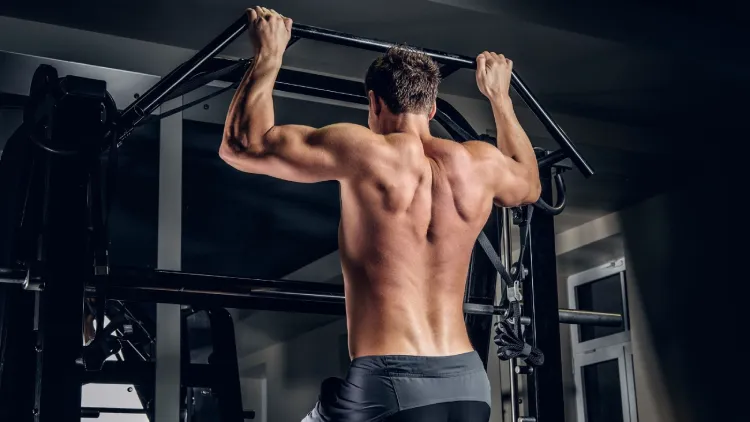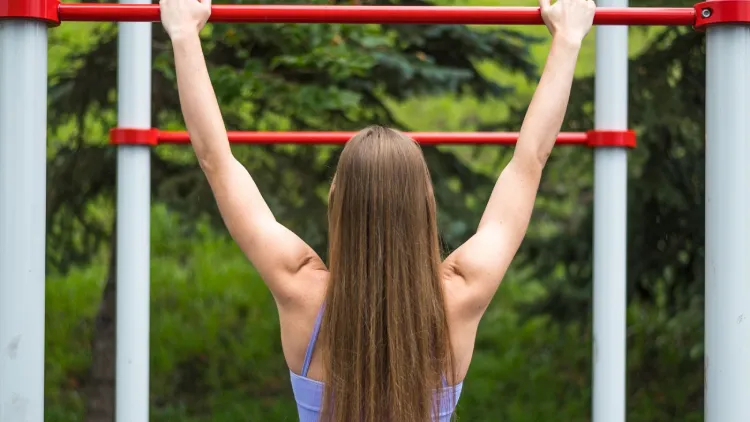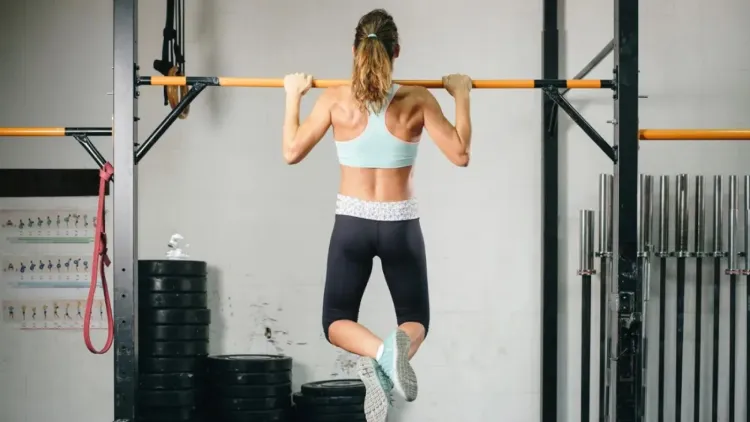Pull ups are among the strongest exercises of body weight, which assist in developing body strength, body mass, and endurance. These work large body parts, including the lats, biceps, shoulders, and the core muscles, giving us an overall upper body growth. Pull ups enhance grip and posture, and also athletics. Regardless of your goal of 5 or 20 pull-ups a day, you can change your physique, increase testosterone, and improve overall fitness, provided that you practice them in proper form and regularly.
- What Are Pull Ups?
- What Muscles Do Pull Ups Work?
- How to Do Pull Ups Correctly
- Common Mistakes to Avoid
- Benefits of Pull Ups
- There are several Pull variations
- Which is better: Pull-up or Chin-up up or Lat Pulldown?
- What is the Number of Pull Ups You Do Daily?
- Can the Pull Ups Strengthen and Build Muscle?
- What is the number of exercises you need per workout?
- Negatives of Pull Ups
- Final Thoughts
- Frequently Asked Questions
What Are Pull Ups?
Pull ups are one of the usual exercises in the upper body which involve you having to use your whole body, with just the back and arm muscles. You do them by taking a horizontal bar with your face turned away and pulling yourself up till your chin goes over the bar. This motion works on various muscle groups, which is why it is one of the best exercises that can be used in fitness.
The primary appeal of pull ups is their simplicity, namely, that there are no machines provided, no heavy weights. You can do them pretty much everywhere, at a gym, in the house, or even at an outdoor bar that is sturdy. Pull ups make you stronger and more sustainable in the day-to-day chores and other sports. Many people consider it as a display of power to be capable of doing at least a pull up because this activity requires coordination, control, and balance of the body.

What Muscles Do Pull Ups Work?
Pull ups are mainly aimed at your latissimus dorsi (lats) – the broad V-shaped muscles that can be seen defining the width of your back and make it look strong. Though this is also the activity of several other muscles that cooperate in the movement:
- Biceps Brachii: Helps in pulling movements and helps to define and increase the size of the arm.
- Trapezius and Rhomboids: Hold the scapula movement and position, and empower the back muscles.
- Deltoids: The shoulders should be stabilised, which helps to lift and raise them in a controlled manner.
- Core Muscles: Used to ensure that your body is straight and does not swing around.
- Forearms and Grip Muscles: These muscles are developed similarly to the grip power necessary in lifts and sports.
Pull ups make your upper body muscles more coordinated and generate balanced strength because the pull up targets so many muscles at a time.
How to Do Pull Ups Correctly
The form and technique are major in this regard to maximising the advantages of pull-ups. They should be done as follows:
- Grip the Bar: Believe in the Bar. An overhand grip, but narrower than the width of the shoulders.
- Practice the Core: This is where you maintain the abs and legs straight or semi-crossed behind you.
- Pull Up Smoothly: You need to start the movement by using your back and drawing your chest to the bar. Avoid jerky motions.
- Chin Above The Bar: Grab hold of the bar all the way through until you get the chin over the bar pushed together with your shoulders.
- Lower with Control: Set down both legs one by one and then straighten the arms where they are. This stage of strangeness makes your muscles stronger.
Complete every repetition under control with a result of concentration on muscles instead of speed. Breathe out, pushing up, and breathe in, pushing down.

Common Mistakes to Avoid
Although the pull-ups are not perceived to be complicated, there are numerous errors that people make that restrict their growth or strain them. Avoid these common errors:
- Momentum: Momentum is used by swinging your body to acquire the momentum, but this decreases the use of the muscles.
- Partial Reps: They reduce strength gains since they are not taken through an entire variety of motion.
- Wrong Grip Width: Gripping is either too big or too small to strain the shoulders.
- Ignoring the Core: The poor form and instability result from the lack of engagement in the core.
- Overtraining: Excessive pull ups with no rest time may result in fatigue injury of muscle injury.
Vertical implementation will guarantee the greatest strength and muscle with minimum risk.

Benefits of Pull Ups
Pull-ups have many physical and performance advantages that render them a necessary workout in any physical activity.
1. Builds a Strong and Wide Back
Pull-ups are incomparable to other exercises as far as tightening and thickening the back muscles are concerned. They develop the lats and upper back, thereby strengthening the V-shape physique.
2. Boosts Functional Strength
Pull-ups enhance real-life strength as the movement resembles real-life pulling activities. They condition your body to be a whole.
3. Strengthens the grip and the forearm
Frequent pull ups make you have a better grip, which helps in other body exercises such as deadlifts, rows, and even rock climbing.
4. Improves Posture and Stability
Training the upper back and shoulders will assist in correcting the round posture and enhancing the straight posture.
5. Dietary protein promotes loss of fat and growth of muscle
Being a single movement taking place in one structure, the pull-ups consume a lot of calories and at the same time construct the muscle. Approximately 10-20 calories can be burnt, equivalent to 20 pull ups, depending on the weight of body weight. Doing 20 pull-ups a day and doing 100 per day can make the upper body stronger and build stamina, and overtraining may happen in case the pull-ups are not done correctly.
6. Enhances Testosterone and Hormones
Since the pulling up exercise involves the use of large muscles, it promotes the production of testosterone naturally, which will help in building muscle and energy.
7. Builds Biceps and Arms
Pull-ups are linked to extensive use of the biceps, particularly in such variations as the chin-ups or the neutral grip pull-ups. Regular exercises result in visible arm sculpture.
8. Improves Mental Discipline
Success in pull-up development instils confidence and psychological strength. Individual repetition is a challenge of patience and concentration, which forms a more resilient mindset with the body.
There are several Pull variations
Pull-ups may be modified to fit all levels of achievement, both the novice and the professional sportsperson. The following are some efficient alternatives:
- Chin Ups: These are done with palms out to sea and give more attention to the biceps and the chest.
- Wide-Grip Pull Ups: You can further widen your hands to separate the lats and build a possibly bigger back.
- Neutral Grip Pull Ups: Hands are opposite to each other – a variety with a joint-friendly aspect that is constructive to build the arms and the back equally.
- Assisted Pull Ups: Go ahead and use resistance bands or a machine to hold your body up in case you are still building strength.
- Weighted Pull Ups: Make the workout harder by using a dip belt or a vest is extra resistance.
- Commando Pull Ups: Hold the bar together and use the obliques and the forearms to alternately push your shoulder towards the bar.
Such differences not only ensure that you have an interesting workout but also avoid muscle adaptation, which promotes constant development.

Which is better: Pull-up or Chin-up up or Lat Pulldown?
Both pull ups and chin-ups are great exercise forms, though the difference is in the emphasis on the muscle. Pull-ups are more of a back attack, whereas chin-ups will be a little more of a biceps attack. The two can be included in a workout balance.
Pull-ups are more practical and rigorous than the lat pulldowns, as you pull your entire weight. Lat pulldowns are, however, an excellent option when one is just starting to develop the required strength. A mix of the two aids you to acquire size, control and stamina.
What is the Number of Pull Ups You Do Daily?
To be strong and build muscles, set goals of 3-4 sets of 5-10 good pull-ups. Novices may begin with assisted pull-ups or negatives. Endurance and muscle toning can be achieved through 20 pull-ups a day, although when you strive to be big, rest and recovery are essential. Pulling up 100 times a day can result in overtraining in the case of a lack of appropriate nutrition and rest.
Most men would average 5-10 pull-ups, and 20 pull-ups are very impressive. Very few men can go beyond that figure because it takes a very high strength-to-weight ratio.
Can the Pull Ups Strengthen and Build Muscle?
Absolutely. Pull-ups will strengthen the upper body by using a variety of muscles simultaneously. When they are done gradually with proper nutrition, they promote hypertrophy (muscle growth). Pull-ups, in the course of time, can gain you power in other body exercises such as push-ups, rows, and curls.
Whereas bicep curls are isolation pull exercises on the arm muscles, the pull-ups develop functional strength of the arms and the back. When you combine pull-ups with push-ups, where the body parts you are training include chest, triceps, and shoulders, you would have developed the upper part of your body completely. They can build muscle with just pushups, but the element finishing the process is the pulling strength, which can be achieved with pull-ups.
What is the number of exercises you need per workout?
To achieve the best muscle development, the number of exercises to be performed per workout should be 4-6, with the incorporation of some compound exercises such as the pull-ups, the push-ups, the rows, and the curls. This is to maintain muscular diversity and equal growth.
Negatives of Pull Ups
Although the pull-ups are highly advantageous, an excessive number of them or improper use may result in:
- The strain on the shoulder or in the elbow is caused by improper form.
- Complete fatigue and overtraining plateau in muscles.
- Impatience should there lead to frustration when progress is slow, particularly when it comes to beginners.
- These problems can be avoided by balancing your routine with a sufficient amount of rest, stretching, and complementary exercises.

Final Thoughts
Pull-ups form one of the best exercises in building strength, muscularity, and stamina in the upper body. They develop the back, the biceps, and the core, and enhance the posture, balance and athletic performance. It can be 5 pull-ups a day or trying to do 20; consistency and proper form are unbelievable. Pull-ups are a must-have of any effective workout regimen, as they strengthen the body and mentally make one tougher and more confident.
Frequently Asked Questions
1. What is the number of pull-ups to begin with?
All you need at the beginning is 3-5 sets of as many pull-ups as you can properly perform. Even one good rep is progress.
2. Can pull-ups develop lats and biceps?
It is true, pull-ups are great in building strong lats, biceps and forearms.
3. Are pushups better than pull-ups?
Both are excellent; pull-ups train the back and the arms, and push-ups train the chest and the shoulders. Working together gives a balanced exercise.
4. Do pull-ups raise testosterone and burn calories?
Yes, they involve heavy muscle groups, and they help to release testosterone and burn calories, about 1020 in 20 reps, based on the weight.







